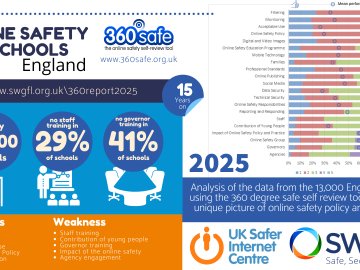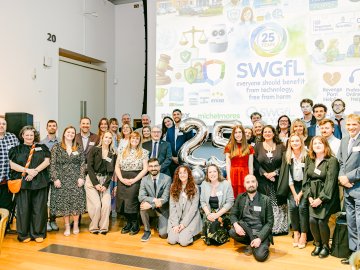Since the release of the Byron Report in 2008 and the subsequent Government action plan that saw the creation of the UK Council for Child Internet Safety (UKCCIS), online safety has been a significant area that remains at the heart of child protection within the UK.
It is becoming increasingly apparent that technology is threaded through many aspects of safeguarding, from sexual predation and exploitation to bullying and child abuse, providing a platform that enables and sustains issues in way that requires a more sophisticated approach when crafting effective interventions.
During that time we have seen UK Government driving:
- Strategies to reduce the amount of illegal child abuse images available to UK internet users
- Significant changes in law to prosecute those who post sexual content without the permission of the subjects involved
- Changes in the Criminal Justice Bill to prosecute those who post hate or racist content
- Strategies to reduce online bullying
- Changes in police policy and procedure to manage the posting of self generated indecent images of children
Whilst these changes to overarching legislation are welcome and provide the right levers for change, measuring the impact of these new strategies can often difficult. Recent research gives indicators that legacy approaches to internet safety education may be having little effect in changing the knowledge and practice of young people.
There are a variety of different curricular resources available, each with their own approach and attendant variance, but no established standards that allow consistent metrics to compare or assess learning and progress.
How do we know that the education programmes we provide are making a difference?
This document outlines the case for developing a set of standards for online safety education that builds on the recommendations of Byron 2008 to develop resilience in children and young people to operate effectively and safely in an online world, the impact of which can be measured against agreed and established outcomes.
The Role of Schools
Schools are are a pivotal component of safeguarding strategy: not just because they are educators and mentors but also the single agency where most children are. Post Climbie, they are the key agencies required to identify, intervene and escalate child protection issues, providing an important intelligence route into the wider, collective agency hub (MASH or otherwise).
Whilst they carry a lot of influence in changing attitudes, they also shoulder an increasing amount of responsibility for the safety and well-being of the children and young people in their care. Many schools have made significant changes to their operational procedures to incorporate online safety into their wider safeguarding strategy; however, online safety education (a significant influence in affecting change) remains, at best inconsistent, and at worst, absent entirely.
What we know; trends in the data.
SWGfL 360 Degree Safe National Data September 2015
SWGfL (in partnership with Professor Andy Phippen of Plymouth University) produce an annual report on school online safety policy and practice, drawn from the 11,000 UK schools that use their 360 Degree Safe Online Safety Self Review Tool. This multi-award winning tool provides a unique and statistically significant data set that allows a “state of the nation” insight into how schools as organisations progress with their online safety strategies.
The report summarises a number of trends that have developed over the five years since the tool’s inception:
Schools’ strongest aspects are:
- having effective connectivity and filtering in place;
- the scope of online safety covered in school policies;
- having effective Acceptable Usage Agreements in place;
- having policy addressing issues around digital images and video;
- having effective online safety policy in place.
The weakest are:
- effective engagement with the wider school community on issues related to online
Safety; - the evaluation mechanisms in place to measure the impact of online safety policy and practice in schools;
- the effectiveness of training for school governors related to online safety;
- the effectiveness of training for staff on matters related to online safety
The progress achieved in standardising operational policy and technical intervention is to be welcomed and there is a global evidence in the report that using the tool has moved schools (and their countries) on with the online safety agenda. However, the gaps in effective staff development and the ability to assess impact have a negative effect on a school’s ability to deliver an online safety curriculum that has positive and measurable outcomes.
And it’s important to remember, this data is based on the eleven thousand of a potential thirty thousand UK schools, who are actively engaged with online safety strategy through the tool. We have no data on the other twenty thousand and can only make broad assumptions.
Ofsted Online Safety Survey Data July 2015
In March 2015, SWGfL were instrumental in developing a data gathering initiative with Ofsted, following on from the 2010 Ofsted report “Safe Use of New Technologies.” Across 87 HMI-led Section 5 inspections during the whole of March 2015, we injected a series of questions on online safety aimed at students, school leaders, staff and governors. The findings of the exercise were presented by Ofsted Online Safety Lead David Brown HMI, at the UK Child Internet Safety Summit London in July 2015.
Salient findings from the survey concluded:
- Over 25% of secondary students cannot recall if they have been taught about online safety over the last 12 months
- Assemblies and computing/ICT lessons are the main focus for online safety teaching for many schools, although PSHE lessons play a significant role in the delivery of online safety in some schools
- In 2010, the ‘Safe Use of New Technologies’ report recommended that more focus was required on “developing a curriculum for e-safety which builds on what pupils have learnt before and which reflects their age and stage of development”. Whilst there is evidence that some schools have embedded this across the wider curriculum, there is inconsistency in the provision of an online safety curriculum with scope and sequence
- Just over a quarter of secondary students lack confidence in their teacher’s knowledge of online safety issues
- Staff training is inconsistent, and what senior leaders might see as training is not reflected by staff. Anecdotal feedback suggests that staff development in online safety is often reactive.
Drivers
DfE “Keeping Children Safe in Education” Statutory Guidance
In July 2016, UK Government Depart for Education updated its statutory guidance for schools “Keeping Children Safe in Education” effective from September 2016.
For all schools and colleges, it is statutory in the sense that schools must have regard to it (they should comply unless exceptional circumstances arise). The requirement derives from Section 175 of the 2002 Education Act and the Independent School Standards 2014 .
Amongst a broad range of advice and recommendations, there are a number of references to a school’s responsibilities in terms of educating young people around safeguarding. In particular:
Governing bodies and proprietors should ensure children are taught about safeguarding, including online, through teaching and learning opportunities, as part of providing a broad and balanced curriculum. This may include covering relevant issues through personal, social, health and economic education (PSHE), tutorials (in FE colleges) and/or – for maintained schools and colleges – through sex and relationship education (SRE)
The text has been changed from “should consider” to “should ensure”, making it clear that this has to be happening in schools. Teaching online safety is not optional. Online safety needs to be taught in all schools and at all ages. It needs to be embedded throughout the curriculum although may fit well into the areas suggested.
Annexe C of the guidance outlines school requirements in specifically in terms of online safety.
Governors and proprietors should ensure that as part of the requirement for staff to undergo regularly updated safeguarding training (paragraph 64) and the requirement to ensure children are taught about safeguarding, including online (paragraph 68), that online safety training for staff is integrated, aligned and considered as part of the overarching safeguarding approach
Again, this requires a more structured and measured approach to online safety by schools than that which the Ofsted survey identified.
Ofsted Safeguarding Schedules
Ofsted (and the other inspectorates) will always make a judgement on safeguarding and “Keeping Children Safe in Education” is one of their main reference points when inspecting safeguarding. This can impact on the overall rating and the implications of a negative rating that come with it. These schedules have been updated with clear references to that document in July 2016, coming into effect in September 2016.
The Ofsted Safeguarding Framework contains numerous references to online safety policy and practice, but specifically around education it states:
Page 15, Section 34 – Arriving at Judgements about safeguarding arrangements
Inspectors will make a judgement on the personal development, behaviour and welfare of children and learners by evaluating, where applicable, the extent to which the provision is successfully promoting and supporting children’s and learners’ safety. In order to make this judgement, inspectors will consider, among other things, children’s and learners’ understanding of how to keep themselves safe from relevant risks such as exploitation and extremism, including when using the internet and social media. Inspectors should include online safety in their discussions with pupils and learners (covering topics such as online bullying and safe use of the internet and social media). Inspectors should investigate what the school or further education and skills provider does to educate pupils in online safety and how the provider or school deals with issues when they arise
For schools this should prompt the questions:
“How do I educate children and young people to build knowledge, skills and capability when it comes to online safety?”
“How do I assess its effectiveness?”
A detailed overview of the implications of “Inspecting Safeguarding” can be found on SWGfL information page “Making Sense of the New Online Safety Standards”
Prevent Strategy (UK Govt)
From 1 July 2015 all schools registered early years childcare providers and registered
later years childcare providers are subject to a duty under section 26 of the Counter-Terrorism and Security Act 2015, in the exercise of their functions, to have “due regard to the need to prevent people from being drawn into terrorism”. This duty is known as the Prevent duty.
It applies to a wide range of public-facing bodies. Bodies to which the duty applies must have regard to the statutory guidance. Paragraphs 57-76 of the guidance are concerned specifically with schools and childcare providers.
In terms of technology being used as a platform to draw people into terrorism, education is again a key factor.
The statutory guidance makes clear the need for schools to ensure that children are safe from terrorist and extremist material when accessing the internet in schools. Schools should ensure that suitable filtering is in place. More generally, schools have an important role to play in equipping children and young people to stay safe online, both in school and outside. Internet safety will usually be integral to a school’s ICT curriculum and can also be embedded in PSHE and SRE. General advice and resources for schools on internet safety are available on the UK Safer Internet Centre website
Again there are clear cross references to Ofsted and DfE guidance on a schools providing a progressive, integrated online safety curriculum that is threaded through the wider culture of the school with demonstrable positive outcomes.
So what?
It’s a good question. And one that inspectorates often ask. So you have a policy? So you have filtering and monitoring in place? So you have a curriculum?
- How do you know the things you have put in place are making a difference?
- Are you building a resilience in children and young people to deal with online issues when adult supervision or technology is not there to do so?
- Do staff feel empowered to intervene in these issues and shape behaviour and culture?
- Do parents and the wider school community support, value and rely on what you provide?
Possibly the reason why inspectorates seldom advise on strategy and the best route; more on what has been achieved.
Whilst school’s can glean some indicators of impact from methods like student and parental surveys, again, these lack consistency in terms of:
- the questions asked
- the way responses are framed
- how the results are analysed
- how those results are benchmarked.
They can often end up as “self-fulfilling” and lack objectivity.
Online Safety Education Standards
What is the business case for a set of standards for assessing online safety, literacy and digital citizenship and where does it sit within the priorities schools have?
The efficacy of standards
Creating a set of agreed and established criteria to monitor progression and award achievement has been at the heart of the UK approach to education for many years; often driven by examinations at strategic points in the year we understand that it may often drive an “exam culture” that prioritises a narrow and hierarchical curriculum that feeds that data by which schools are often held to account.
However, defining expectations has the benefit of establishing entitlement in terms of curriculum. Not only does it provide an evaluative benchmark, but also sets out a level playing field for learners. An interesting perspective is that, whilst the former standards around internet provision for schools may have seen draconian, the single powerful outcome was that it established clear entitlement for every learner regardless of geography.
We know too that schools have a certain autonomy in setting their own curriculum for any subject area , as long as it is ensured it reflects the breadth and balance provided by the National Curriculum. Defining a set of expectations for online safety would assist in mapping that curriculum not only for student achievement but assist schools with meeting the requirements of PREVENT and “Keeping Children Safe in Education”.
SWGfL were the first organisation in the UK to begin to map standards in school improvement, policy and practice in Online Safety through the 360 Degree Safe Tool. Six years of national data and reports, analysed written and managed by Professor Andy Phippen of Plymouth University, demonstrate unequivocally that those standards have changed the landscape. They have moved schools, practitioners and the four nations on.
Given the journey we have made with 360 degree safe in defining a set of benchmarks and the rich conversation; progression and comparisons it engenders, it seems right to replicate that experience. 360 allowed access to detailed data from 11000 schools on school improvement barriers and successes; the last part of the picture is to appreciate whether school online safety strategy affects student achievement, behaviour or culture.
What “standards” already exist for Online Safety Education?
As an initial part of this review, we examined the current landscape across a variety of frameworks, national, international and commercial to understand scope, progression and where there were common threads and themes.
The list is available in the document here: http://bit.ly/2lmTxlf
Whilst this list is not exhaustive it allowed an understanding of what has been or is currently being developed. Some of those findings are explored below.
National Curriculum for Computing (England)
There is a strand within the National Curriculum for Computing on “responsible use”:
- (Users are) are responsible, competent, confident and creative users of information and communication technology.
This strand is further expanded through references in the attainment targets at each Key Stage:
KS1
- use technology safely and respectfully, keeping personal information private; identify
where to go for help and support when they have concerns about content or contact on the internet or other online technologies.
KS2
- use technology safely, respectfully and responsibly; recognise
acceptable/unacceptable behaviour; identify a range of ways to report concerns about content and contact.
- use search technologies effectively, appreciate how results are selected and ranked, and be discerning in evaluating digital content
KS3
- understand a range of ways to use technology safely, respectfully, responsibly and securely, including protecting their online identity and privacy; recognise inappropriate content, contact and conduct and know how to report concerns.
KS4
- understand how changes in technology affect safety, including new ways to protect their online privacy and identity, and how to identify and report a range of concerns.
These are supported by the QuickStart Computing guides from the BCS/CAS, online safety materials:
Primary: http://primary.quickstartcomputing.org/resources/pdf/safe_responsible.pdf
The Secondary version of QuickStart Computing has little or no reference to responsible use in an age group where many of these issues escalate in terms of online life, focusing instead on building competency in programming, computational thinking and developing opportunities.
Whilst the references to responsible use within this programme of study should be applauded, there is an argument that challenges whether this aspect of behavioural education should appear within the Computing Curriculum alone.
National Digital Literacy Frameworks
There is some excellent work going on across the UK, Europe and US in mapping broader digital literacy skills from the point of view of technology and many of the schemes examined in the landscape study mentioned above, have a common thread; that around effective and empowering use of technology to support learning and amplify voice.
The Welsh Government’s Digital Competence Framework has well-defined strands on Citizenship and Communication and maps them to broader technical competencies; this approach of mapping expected behaviours, knowledge and skills for each age/developmental stage is useful in establishing a curriculum that shapes and allows discussion/learning for young people’s attitudes to technology and how they influence outcomes.
Establishing expectations; what might they look like?
SWGfL have a long and proven legacy in the Online Safety field; we are privileged to have worked with tens of thousands of schools, professionals, students, pupils and families. We work closely with Government and have shaped much of current national thinking in this area, not least of which has been with the DfE, Ofsted, Home Office, DCMS and GEO. We also contribute to the broader global developments in online safety across Europe, the US and the Middle East.
In response to the findings and commentary from the Office of the Children’s Commissioner England “Growing up Digital” Jan 2017 SWGfL have begun to develop a framework and supporting content to assist schools in mapping what a child of a certain age/developmental stage would be expected to know in terms of the current online technical landscape and how that shapes their own behaviour and vulnerability.
In working towards these expectations, our focus has been on designing a set of outcomes that will:
- Map entitlement
- Allow learners to benchmark their own progress
- Inform teaching
- Inform local strategy
- Inform national strategy
This new framework and mechanism is 360EVOLVE and will be provided free for all schools.
We have begun by;
Describing a global progression through the scheme mapped to Key Stage:
- EYFS/KS1 Focusing on developing self
- KS2 Focusing on developing self and the effects of actions/behaviour on
- immediate peers
- KS3 Focusing on the impact of actions/behaviour on wider social group: school, family, online social group, club, team etc
- KS4 Impact on wider society focusing on ethics, social norms and legislation
Establishing a set of eight strands that outline horizontal progression across age:
- Self Image and Identity
- Relationships and Communication
- Digital Footprint and Reputation
- Online Bullying
- Information Literacy
- Health, Well-being and Lifestyle
- Privacy and Security
- Creative Credit and Copyright
These strands loosely match the existing strands in the SWGfL “Digital Literacy & Citizenship Curriculum” Resource developed with Common Sense Media
EXAMPLE Single Self Image and Identity Strand
Resources mapped to each statement that include:
- Activities designed to produce an outcome evidencing achievement against the statement
- Assessment criteria to aid teacher/student judgement
- Resources embedded to support the activity
- Links to further advice, support, research for professional development
EXAMPLE Year 1 Self Image and Identity Resource page
An online portal free at the point of delivery for all schools that will:
- Allow schools to rapidly populate the mechanism with student cohorts
- Teacher dashboard to assist with recording achievement and manage assessment
- Student dashboard to self assess and track progress
- Reporting features to benchmark progress across individuals, groups and cohorts for both students and staff
- Accreditation system to celebrate achievement and progress
EXAMPLE Draft Design for Online EVOLVE Portal
Evaluating Impact
In it’s simplest form, such a framework may very well be used to inform curriculum planning; how, when and where aspects may be taught.
Through the reporting features of a mechanism designed to manage that content, then it gives access to detailed data on progress and achievement for a school to:
- Inform the curriculum
- Assess impact of teaching and learning
- Benchmark achievement across groups
- Celebrate achievement
- Feed that expertise back into the programme
However, it also gives a unique dataset to establish national trends and perspectives using anonymised data from the tool, much in the same way 360 Degree Safe can engender “State of the Nation” reports from its 11000 users that include:
- National trends
- Geographical trends
- International trends
- Improvement over time
- Information on targeting resource
- Shaping government policy
In Conclusion
The “digital natives; digital immigrants” postulate is a myth; it died from the moment it attempted to describe young people’s attitudes to online technology. Behaviour and technology have both moved on and so should our thinking.
As our children learn to make their way in the world, we provide environments where they can learn to take risks in a managed and supported way; we encourage risk to allow children to fail constructively, whether that is offering answers in class or abseiling down a rock face for the first time. There are mechanisms to support, educate, improve and intervene on the rare occasions that lead to harm. For the most part, these educative experiences are built on prior knowledge with direction and progression.
The behaviours we see emerging from the online lives of young people are for the most part indigenous and a product of the environment in which they find themselves and historically have had little or no guidance or intervention that affects change.
Change that empowers; change that builds resilience to harm; change that creates a culture that migrates naturally towards the positive rather than the transient, easy or unempathetic.
The legacy messages around online safety may satisfy our obligations to teach in this area but there is little evidence that they have affected any real cultural change. Children are good at barking back the messages you have covered in the lessons but evidence suggests it doesn’t change things. Most are borne from a negative philosophy.
- DON’T POST PRIVATE INFORMATION ONLINE
- ONLY HAVE FRIENDS YOU KNOW IN REAL LIFE
- THINK BEFORE YOU POST
- DON’T MEET UP
- SET PRIVACY RULES AND SETTINGS
They are messages that don’t even resonate with us let alone children and young people swimming in this online ocean every day of their lives. They were of a time; they require more depth and sophistication if they are to engender the right conversations to engender positive outcomes.
360EVOLVE are our first attempts to shape those messages in a way that promotes change and supports educators in shaping that approach.
It’s a long journey that may not immediately impact on this current generation of young technology, but paves the way for the next.
We will be posting information on 360EVOLVE free for anyone to use in the coming months at 360evolve.org.uk (Available soon)
It would be great to have you with us on the journey.






